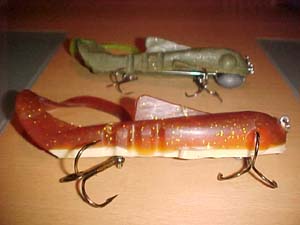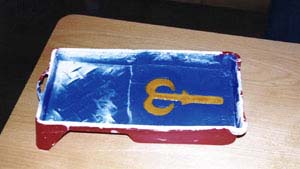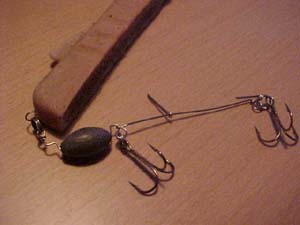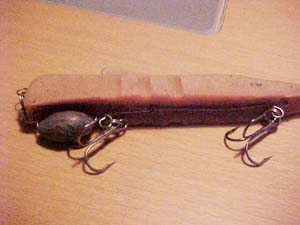

 I've been working on pouring my own softbaits for about a year now. Inspired by an article from Herman van Barneveld that I read on www.totalfishing.nl I started experimenting with all sorts of styles and types of softbaits. I started pouring my own softbaits for jig fishing for zander. And the results were quite good. I had the feeling that on some days my plastic lures outfished other factory made ones. Coincidence? Probably but in any case it was a great stimulus for me to continue. After this I started experimenting with sluggo's and just recently I started pouring bulldawg-like creatures!
I've been working on pouring my own softbaits for about a year now. Inspired by an article from Herman van Barneveld that I read on www.totalfishing.nl I started experimenting with all sorts of styles and types of softbaits. I started pouring my own softbaits for jig fishing for zander. And the results were quite good. I had the feeling that on some days my plastic lures outfished other factory made ones. Coincidence? Probably but in any case it was a great stimulus for me to continue. After this I started experimenting with sluggo's and just recently I started pouring bulldawg-like creatures!
In what follows I will explain to you step-by-step how I go about pouring my own softbaits. Probably there are better ways and methods (I'm always interested in hearing about them!) but this is the way I've gone about it up to now.

Creating a mold
To make a softbait, the first thing we'll have to do is create a mold. My first mold was made from a FT-shad. First I take a plastic box and I fill it with plaster (the material used to stabilize floors can be used as well). Next I position the FT-shad very gently in the plaster and I make sure there is no plaster on the back of the shad. Make sure the tail is positioned in the normal position otherwise you'll get a bent tail or a tail that might break off when you try to remove the poured softbait from the mold. After the plaster has hardened fully, remove the shad carefully. This mold is ready to be used.
By repeating this process, you can make a mold of about any softbait available in stores. Look at the pictures for some of my creations.
I use plaster or stabilizer but it's even possible to use clay (as has been described in the article of Herman van Barneveld. I however don't have experience with this.

Melting softbaits
Because I haven't found an alternative yet, I use used plastic shads for pouring my own softbaits. Those are softbaits that have been bitten to shreds
To start I cut the shad I want to melt in tiny bits and pieces. Next I put all these pieces in a cup and I put that cup in the microwave. Make sure you don't use high power! If you do the plastic will start to boil and air bubbles will get trapped in the melted plastic. I use a power of 450-600Watt, and I check regularly to see if the plastic has fully melted. It's important to stay with it to avoid problems. When it is completely melted, it's time to pour the plastic in the mold.
If anybody uses a different material to melt, I would love to hear about it. Herman van Barneveld uses "soft-plastic" but as far as I know it's only available in the United States. I've tried a lot of different materials but I haven't found a decent replacement plastic. If anybody knows a good alternative, please let me know.

Pouring of the softbait
Before I pour the softbait, I always rub some olive oil or oil from sunflowers so the shad can easily be removed after this step in the process of pouring the softbait. Especially the thinner tail part is difficult to remove and the tail may actually break when you try to remove the shad. To prevent this, I use some oil so make sure the plastic doesn't attach itself to the plaster.
Next I fill the mould completely. Make sure you pour the melted plastic in one fluent motion. Take into consideration that this melted plastic will shrink a bit when it has hardened so pour the melted plastic in the mold so a slight bubble appears on the back. You can use different colors and glitter powder as well when pouring the melted plastic.
After a few minutes the softbait has hardened anough for you to remove it from the mold. Make sure you do this cautiously to eliminate the chance of breaking the tail or tearing the melted plastic. Next put the softbaits in a sink with cold water for the last part of the hardening process.
It's up to you to experiment with all sorts of shapes!
I have found out that when you use factory made shads to melt for use as a base material for new softbaits, the new softbaits tend to get a bit softer. For instance a new softbait made from a melted Culprit shad is hard to glue to the jighead with loctite afterwards.
Good luck!
Peter Broers


 I've been working on pouring my own softbaits for about a year now. Inspired by an article from Herman van Barneveld that I read on www.totalfishing.nl I started experimenting with all sorts of styles and types of softbaits. I started pouring my own softbaits for jig fishing for zander. And the results were quite good. I had the feeling that on some days my plastic lures outfished other factory made ones. Coincidence? Probably but in any case it was a great stimulus for me to continue. After this I started experimenting with sluggo's and just recently I started pouring bulldawg-like creatures!
I've been working on pouring my own softbaits for about a year now. Inspired by an article from Herman van Barneveld that I read on www.totalfishing.nl I started experimenting with all sorts of styles and types of softbaits. I started pouring my own softbaits for jig fishing for zander. And the results were quite good. I had the feeling that on some days my plastic lures outfished other factory made ones. Coincidence? Probably but in any case it was a great stimulus for me to continue. After this I started experimenting with sluggo's and just recently I started pouring bulldawg-like creatures!


